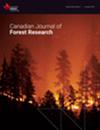北方阔叶林树木和倒下木材的生物量积累:美国新罕布什尔州连续时间序列的重复测量 & # x0D;
IF 1.5
3区 农林科学
Q2 FORESTRY
引用次数: 0
摘要
演替次生林在北美东部大部分地区占主导地位,因此,立木和砍伐木材的生物量积累模式对森林管理和碳核算具有重要意义。森林发展后期生物量积累的时间和规模尚不完全清楚。我们采用“时间序列与重新采样”的方法来表征新罕布什尔州怀特山脉16个北方硬木林分的活生物量和死生物量积累。地上活生物量迅速增加,145年后稳定在350毫克/公顷左右。倒下的木材生物量在10至35毫克/公顷之间波动,取决于干扰。被砍伐木材的种类组成随林分演替的变化呈可预测的变化,被砍伐木材的总质量随林龄的增加而增加。早演替树种自疏过程中,细木屑在30 ~ 50年达到峰值,尤其是针叶樱桃。我们的数据支持北方阔叶林发展模型,其中活树生物量渐近积累,并在约140-150年开始趋于平稳。然而,145年次生林与原生林在活度(p = 0.09)和倒下树木直径分布(p = 0.06)上存在差异。如果没有对不同年龄的林分进行重复测量的时间序列,就很难发现森林生物量积累的这些模式。本文章由计算机程序翻译,如有差异,请以英文原文为准。
Biomass accumulation in trees and downed wood in northern hardwood forests: repeated measures of a successional chronosequence in New Hampshire, USA
Successional, second-growth forests dominate much of eastern North America, thus patterns of biomass accumulation in standing trees and downed wood are of great interest for forest management and carbon accounting. The timing and magnitude of biomass accumulation in later stages of forest development are not fully understood. We applied a “chronosequence with resampling” approach to characterize live and dead biomass accumulation in sixteen northern hardwood stands in the White Mountains of New Hampshire. Live aboveground biomass increased rapidly and leveled off at about 350 Mg/ha by 145 years. Downed wood biomass fluctuated between 10 and 35 Mg/ha depending on disturbances. The species composition of downed wood varied predictably with overstory succession, and total mass of downed wood increased with stand age and the concomitant production of larger material. Fine woody debris peaked at 30-50 years during the self-thinning of early-successional species, notably pin cherry. Our data support a model of northern hardwood forest development wherein live tree biomass accumulates asymptotically and begins to level off at ~140-150 years. Still, 145-year-old second-growth stands differed from old-growth forests in their live (p = 0.09) and downed tree diameter distributions (p = 0.06). These patterns of forest biomass accumulation would be difficult to detect without a time series of repeated measurements of stands of different ages.
求助全文
通过发布文献求助,成功后即可免费获取论文全文。
去求助
来源期刊
CiteScore
4.20
自引率
9.10%
发文量
109
审稿时长
3 months
期刊介绍:
Published since 1971, the Canadian Journal of Forest Research is a monthly journal that features articles, reviews, notes and concept papers on a broad spectrum of forest sciences, including biometrics, conservation, disturbances, ecology, economics, entomology, genetics, hydrology, management, nutrient cycling, pathology, physiology, remote sensing, silviculture, social sciences, soils, stand dynamics, and wood science, all in relation to the understanding or management of ecosystem services. It also publishes special issues dedicated to a topic of current interest.

 求助内容:
求助内容: 应助结果提醒方式:
应助结果提醒方式:


